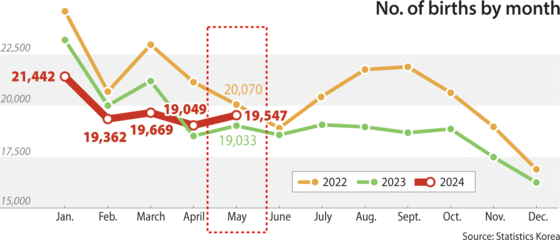Foreigners in Korea drove reversal in population decline last year: Data
![Students get information from advisers at an employment fair designated for jobs linked to the Regional Specialization Foreign Talent F-2-R visa at an international job fair. [SONG BONG-GEUN]](https://koreajoongangdaily.joins.com/data/photo/2024/07/29/c4e506b2-3ba0-4f8b-a09d-884fd48d7ea1.jpg)
Students get information from advisers at an employment fair designated for jobs linked to the Regional Specialization Foreign Talent F-2-R visa at an international job fair. [SONG BONG-GEUN]
A surge in foreign residents drove a population uptick in Korea last year that reversed a two-year decline fueled by one of the world’s lowest birthrates.
According to census data released by Statistics Korea on Monday, the population stood at 51.77 million as of November of last year, a 0.2 percent increase compared to the same period a year prior.
The on-year uptick marked a rebound from a two-year decline, as the country’s population shrank 0.2 percent in 2021 and 0.1 percent in 2022.
The number of residents with foreign nationalities jumped 10.4 percent, or by 180,000, to 1.94 million. The figure accounted for 3.7 percent of the country's total population, up 0.3 percentage points from 3.4 percent in 2022.
Conversely, the number of native Korean residents shrank by 0.2 percent, or 100,000, to 49.84 million, posting the third consecutive decrease.
The number of multicultural households also increased, up 4.1 percent to 416,000.
Meanwhile, the aging trend among the population persisted last year.
The working-age population, between 15 and 64 years old, took up 70.6 percent of the total, down by 0.4 percentage points from the previous year. The proportion of the working-age population has been in constant decline since 2018.
The elderly population, on the other hand, continued to grow, accounting for nearly one-fifth of the total. The number of individuals aged 65 and older rose 5 percent to 9.61 million, representing 18.6 percent. For native Koreans, the elderly population accounted for 19.1 percent, or 9.5 million.
This brought the median age to 45.7 years old, up 0.6 years from the previous year.
The number of people living alone continued to grow as well.
Single-person households accounted for 35.5 percent of the total last year, representing 7.83 million households, up from 34.5 percent in 2022. On the other hand, families with four members or more took up 16.8 percent, compared to 17.6 percent a year prior. As a result, the average number of family members in a household declined from 2.25 people in 2022 to 2.21 people.
Korea has been grappling with a chronically low birthrate. The total fertility rate — the average number of children expected to be born per woman over her lifetime — reached a record low of 0.72 in 2023, far below the 2.1 births per woman needed to maintain a stable population without immigration.

However, the figure saw a slight uptick as of late, as the number of births reported an on-year increase for two months in a row in April and May, driven by a post-pandemic rebound in marriages and a base effect from the all-time low last year.
BY SHIN HA-NEE [shin.hanee@joongang.co.kr]










with the Korea JoongAng Daily
To write comments, please log in to one of the accounts.
Standards Board Policy (0/250자)